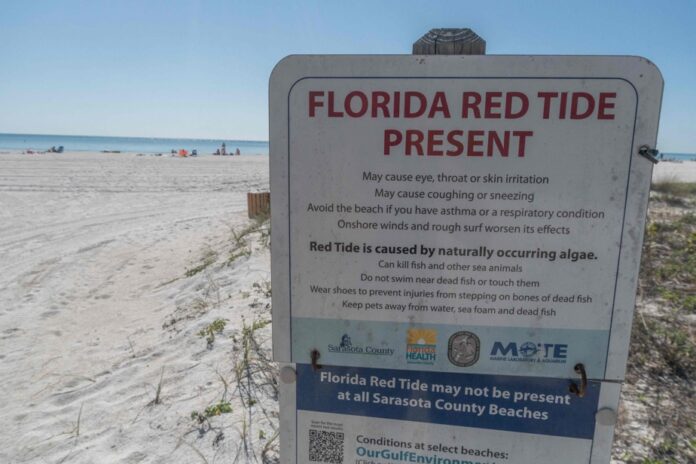(Sarasota) Sun, white sand and turquoise water. Lido Key Beach in Sarasota would be a perfect postcard of Florida beaches if dozens of dead fish weren’t lying on the ground as a result of the red tide affecting the west coast of this American state.
This recurring natural phenomenon, caused by the proliferation of the microalga “Karenia brevis”, occurred this year during spring break, the spring vacation during which thousands of young Americans converge on the Florida coast.
“We had a lot of cancellations,” laments Lido Beach Resort employee Jeff Napier, 62. “People are getting sick. Why would anyone want to spend a lot of money and stay here” under these conditions?
When the concentration of this harmful algae is too high, as in recent weeks, it releases a powerful neurotoxin that can kill marine fauna and cause respiratory problems in humans.
Dick Bowser experienced it. “It smelled terrible,” the 80-year-old tourist recalled as he walked along the seaside with a cane in each hand, happy that the sea currents had temporarily pushed the red tide away, giving him a short respite.
“I couldn’t get closer to the beach,” he adds. “I was bothered by a persistent cough. I had a sore throat every day, eye or sinus problems. »
Jeff Napier, he suffered five days of migraine and does not want to relive that. “This red tide has to be addressed,” he says, though he doesn’t know how.
50 km from Sarasota, scientists at the Mote Marine Laboratory have been working since 2020 to mitigate the impact of this phenomenon already known to Spanish explorers of the 15th and 16th centuries after their exchanges with the indigenous populations.
Their goal is to “destroy the algae, alter their toxin, and have no noticeable effect on non-target species,” says Dr. Michael Crosby, president and director of the lab.
Researchers have a 2,600 m2 facility where they grow specimens of Karenia brevis and can test substances to neutralize them in huge seawater tanks that mimic the Gulf of Mexico ecosystem.
They have so far identified a dozen methods that work and will spend the next two years finding the best way to use these solutions in the ocean, Crosby said.
The white-bearded scientist, with a smirk, proudly walks through the six laboratories of the research center, convinced that his team will succeed in reducing the environmental impact of red tides and their consequences on the quality of life and the economy of the region. .
But “we will never be completely rid of the red tide,” he said.
Mainly because unlike other phenomena of proliferation of harmful algae, the result of human activities such as agriculture, this one is natural.
Florida’s red tide begins about 40 miles off the west coast of the state, moving inward or outward from shore depending on sea currents.
This year, the algae eruption is largely due to Hurricane Ian, which hit Florida in late September, according to Dr. Crosby.
Once on the coast, they proliferate in contact with water rich in nutrients, natural or agricultural.
“We are studying the extent to which human activity, particularly land-based nutrient inputs, can accentuate a red tide in terms of intensity and duration,” says Michael Crosby.
“But even if we wiped out all the humans from Florida, there would still be red tides,” he said.
“It’s been like this for hundreds of years,” says Jeff Napier, resigned, in front of the Lido Beach Resort.


















